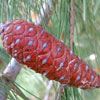Aleppo pine is an evergreen tree that reaches a height of 8 meters, and trees that are not planted densely may reach an even greater height. The tree contains resin ducts in all of its tissues, which secrete and conduct resin. The bark of the trunk and the mature branches is scaly. The leaves are needle-shaped, and are carried in pairs at the head of dwarfed twigs. Only the first leaves of the young plant (juvenile leaves) are carried singly on the young trunk. The leaf persists for several years. The tree produces resin which contains volatile and flammable organic compounds. This property causes it to be extremely flammable and easily damaged by fires. Needles that fall create a carpet on the ground, which suppresses the growth of weeds in pine forests. Cyclamen persicum is an exception that is successful even below pines, where it enjoys little competition.
Pinus halepensis blooms in the spring with tiny single-sex cones (strobili), which are concentrated in dense clusters at the ends of the branches. The female cones are pollinated by wind. The male and female cones grow on the same individual. On the suitable day (the first warm and dry day in spring), the air is filled with clouds of pine pollen, which is dispersed from the male cones that are concentrated in dense clusters at the tips of branches. One ten-year old branch produces 350,000,000 pollen grains annually. The pollen is carried by the wind and reaches female cones which are found near the ends of other branches. The seeds mature only in the third year after pollination. The seeds develop between the scales of the female cones. Only about half of the scales open to release the seeds when they mature. The scales at the base of the strobilus remain closed and may retain the ripe seeds for many years, until they are released by the hot air during a forest fire that burns the tree. This phenomenon, called serotiny, enables the accumulation of a huge seed bank at the tree tops which serves as the basis for regeneration of the pine population following wildfires. The seeds are equipped with a membranous wing, which helps their dispersal by wind. The male cones are brown. The female cones are reddish when young and turn brown as they mature. The pedicel of the mature cone is bent at a sharp angle to the branch on which it sits, thus differentiating it from a related species, Cypriot pine (Pinus brutia), which is also planted in Israeli forests. A stork-shape can therefore be sculpted from Pinus halepensis cones, but not from the cones of Pinus brutia.
Very few natural Pinus halepensis stands can be found in Israel (if at all). Its origin is East Mediterranean. The tree was planted in large areas, especially in the mountain regions, from the Galilee to the Southern Judean Mountains. Planting was begun in the 1920's by the British Mandate Forestry Service, and was continued by the Jewish National Fund. It was chosen as the main afforestation tree because of its high resistance to dry conditions. In some areas it is spreading from the planted forests and penetrating Mediterranean tree and shrub associations. Its scientific name was given after the city of Haleb in Syria.
The genus Pinus presents an impressive variety of cone shapes, and the different species are recognized by the shape of their cone. Pines provide half of the global wood supply for building construction and for furniture. The resin is also economical, and is used for production of glue and turpentine. Differences in the resin and its distribution within the wood tissue of different species are the main factors that determine the quality of the wood and its use. Economic use of pine in Israel is very limited: it is used for producing fiberboard and crates, as well as wood-coal.
Pines are very common in temperate and cool-temperate regions of the Northern Hemisphere. The genus contains 90 species. Contrary to past thinking, some scientists believe that it never grew in Israel in the wild, and all the trees in this country were imported and planted by man, or are descendents of such trees. Pinus halepensis is used extensively for afforestation in Israel, whereas Pinus brutia, Pinus canariensis and Pinus pinea are used less extensively.
The pine’s family also includes the Cedars (Cedrus), which include 3 species in the Old World, from the Atlas Mountains to the Himalaya Mountains. In English, other completely different conifers from other families are also commonly called cedars.
The oldest trees in the world belong to an American group of pines called Bristlecone Pines. They grow in the mountains of Western United States, and are slow growers, such that their extreme aged is not expressed in an impressive and wide trunk at all. One individual that grows in the White Mountains of northeast California has been named “Methuselah” and is considered the oldest living organism on earth. It is about 4,700 years old.
Written by Mike Livne







